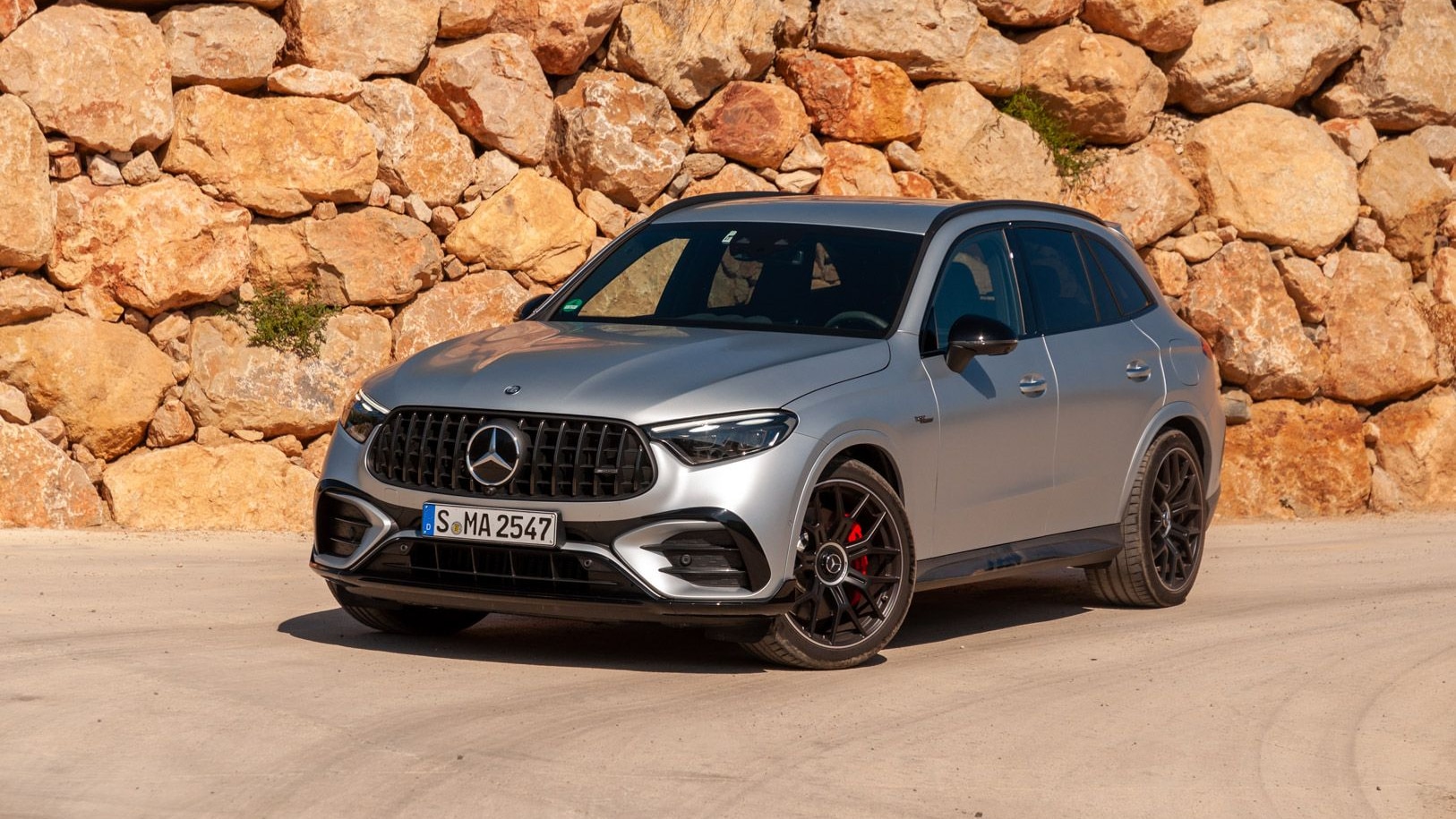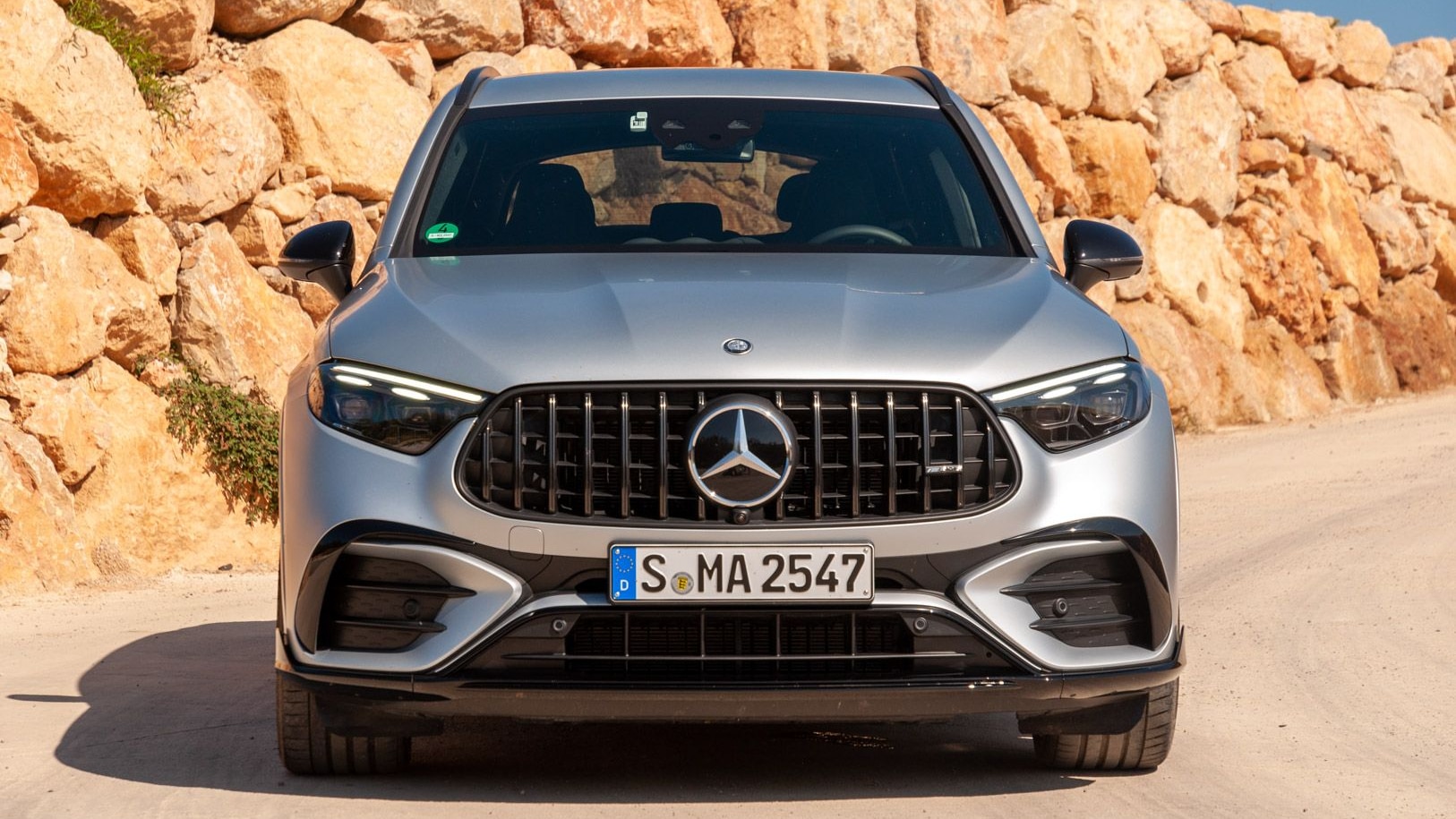Mercedes’ AMG models have traditionally been loud, blunt-force objects. They could often be found going sideways or spewing tire smoke.
But things at AMG are getting complicated as the electrified era comes online. The latest AMGs are precise performance machines that no longer reward hamfisted driving. The plug-in hybrid 2025 Mercedes-Benz AMG GLC 63 S E Performance will bring this type of technically precise driving when it arrives in the U.S. in the second half of 2024.
After spending time behind the wheel of an early build Euro-spec GLC 63 S E Performance (let’s just call it the GLC 63 S for now, shall we?) in Barcelona, Spain, part of me misses the V-8, part kind of loves this plug-in hybrid stepping stone, and part is ready to skip straight to the fully electric future.
2025 Mercedes-Benz AMG GLC 63 S E Performance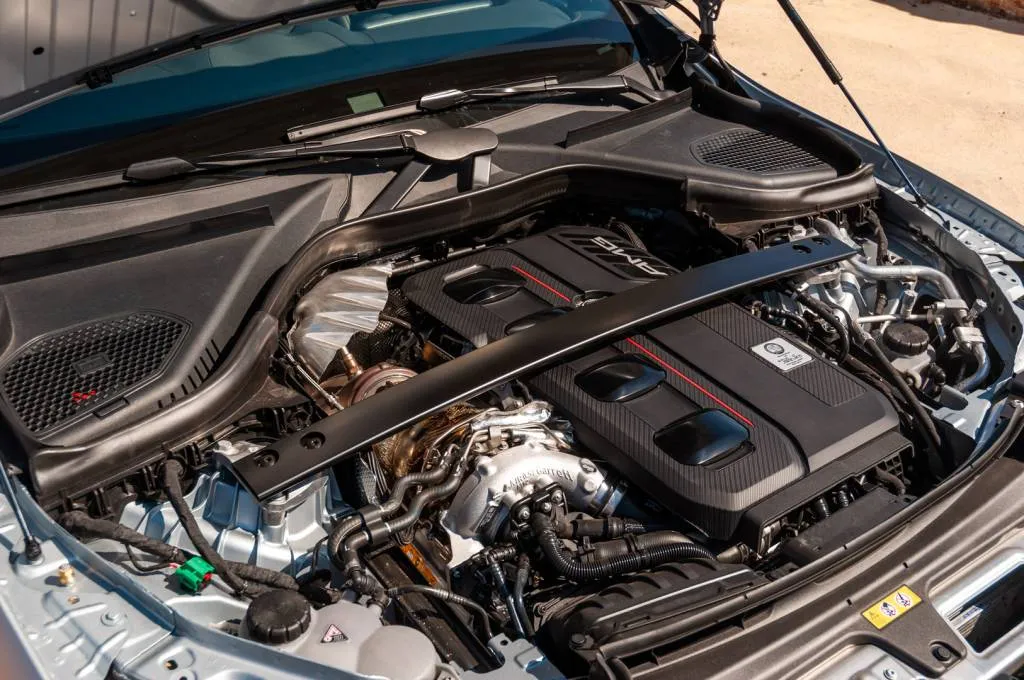
GLC says goodbye V-8, hello complicated hybrid turbo-4
The twin-turbo V-8’s gone. RIP. Under the hood of the GLC 63 S sits a 2.0-liter turbo-4 that makes 469 hp and 404 lb-ft of torque hooked to a 9-speed automatic transmission with a wet clutch. That turbocharger first spools up off of power from the high-voltage battery’s 400-volt electrical system and then the exhaust gases take over. It’s straight Formula 1 tech. There’s also a 201-hp electric motor in the rear packaged with a 2-speed transmission and a limited-slip differential in one housing. The motor is powered by a 6.1-kwh battery developed by the wizards at AMG. It’s the exact same powertrain found in the C 63 S E Performance sedan.
All in, the system develops a whopping 671 hp and 752 lb-ft. As I’ll soon see, that power is robust.
2025 Mercedes-Benz AMG GLC 63 S E Performance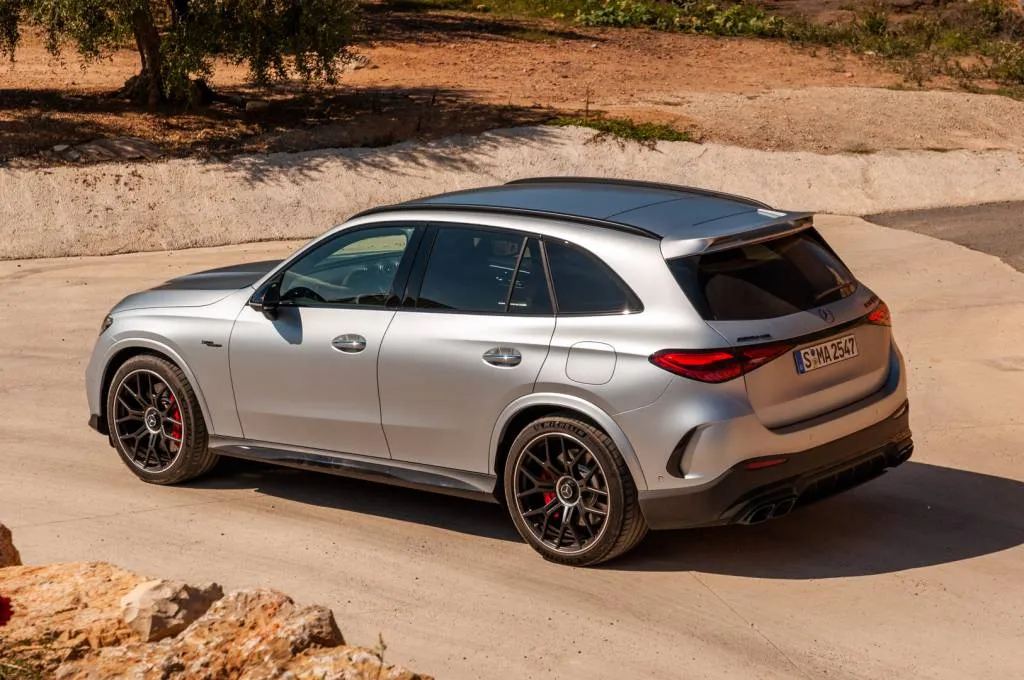
GLC 63 S E Performance has multiple personalities
Pushing the start button on the GLC 63 S’s dashboard brings the 12.3-inch digital gauge cluster and 11.9-inch touchscreen to life, but aside from some humming from the powertrain’s fans you wouldn’t know this thing was running.
Pulling out of the hotel’s parking lot in Comfort mode with a nearly fully charged battery, the gas engine doesn’t fire to life. The GLC starts emitting a faint Starship Enterprise-type noise from an exterior-mounted speaker. It fits with the gauge cluster’s Sport mode’s design theme, which features laser-like lines that shoot out on either side of the digital speed readout as if you’re entering warp speed.
Pushing the skinny pedal down to the three-quarter point kicks on the turbo-4, and the turbocharger spools up quickly. Lag is a thing of the past. Whoops. Brakes, now! This is a city center.
As I head onto the highway I mash the accelerator to the floor, blowing past a detent about 90% of the way through the pedal travel. The full force of 671 hp and 752 lb-ft of torque shoots the matte silver AMG forward and I quickly realize, “I don’t want to go to jail in Spain.” I slow down, but this thing is quick. Mercedes said it launches from 0-60 mph in 3.4 seconds and is governed to top out at 171 mph. My butt dyno says the 0-60 mph time seems accurate, but I’m smart enough not to test the top speed.
Cruising along the highway in Comfort mode, the GLC 63 is quiet despite the turbo-4 running in the backgrounder. There’s the faintest thrum from the sticky Michelin Pilot Sport 4S tires, but the pavement is much smoother than the broken stuff in America. Little wind noise makes its way into the cabin, and the adaptive dampers and air suspension provide a relaxed ride.
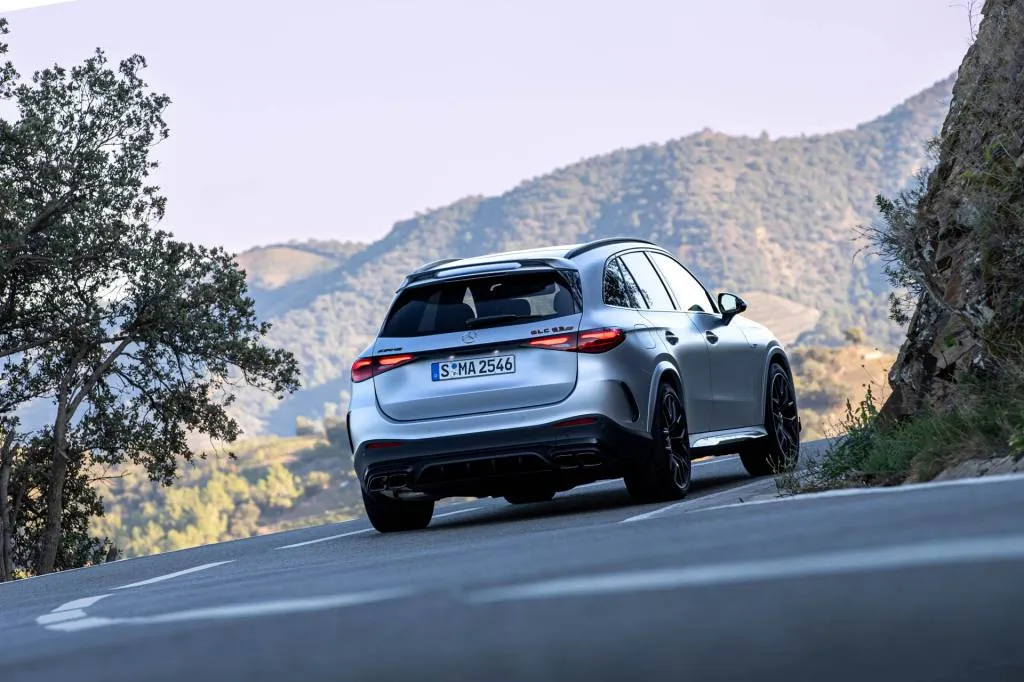
2025 Mercedes-Benz AMG GLC 63 S E Performance
Turning off the highway onto narrow two-lane country roads, I flick the round knob on the steering wheel to Sport mode. The transmission kicks down a gear or two and the suspension firms up a bit. With the quick personality change, the silver AMG is ready to carve corners, but I’m impatient. After a few turns I encounter a small white car going under the speed limit, which is just unacceptable.
2025 Mercedes-Benz AMG GLC 63 S E Performance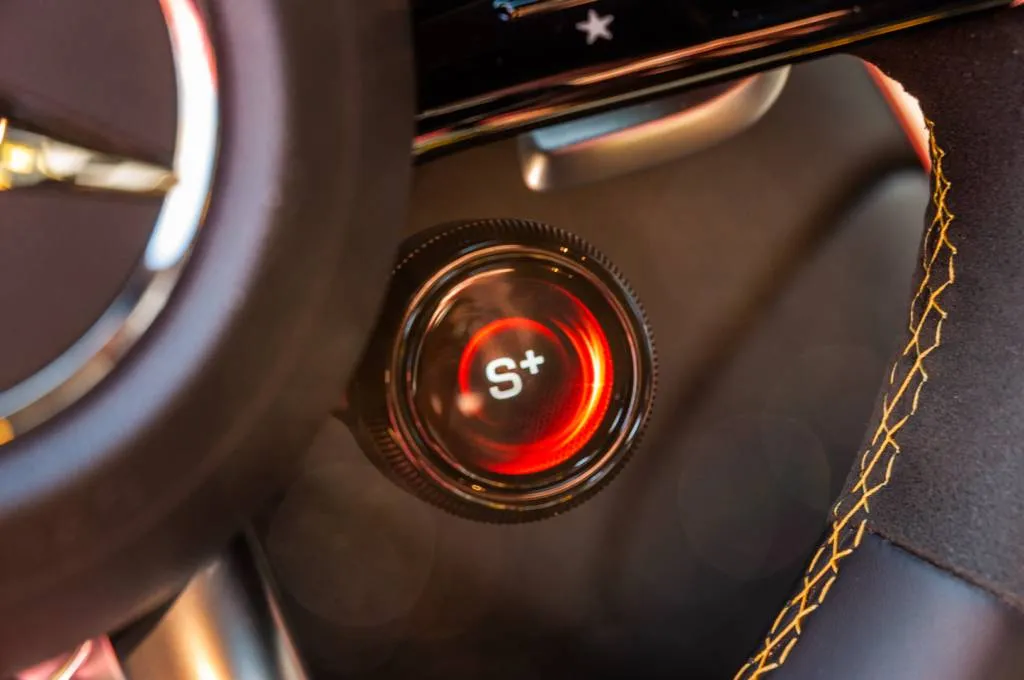
Flicking the drive mode selector into Sport+, the powertrain is cranked to 9, because 11 is saved for Race mode, but that would be excessive for passing an economy car on a two-lane road. I pass the slowpoke quickly, and the GLC’s steering gels with me. It is precise, nicely weighted, and while not telepathic, it is communicative.
Mercedes pulls out all the tricks to make the GLC 63 S E Performance agile. Rear-wheel steering is standard. Under 62 mph, the rear wheels turn the opposite direction as the fronts up to 2.5 degrees, while over that speed the rear wheels turn parallel with the fronts up to 0.7 degree. Combined with AMG’s tuning of the adaptive dampers and air suspension, along with the electromechanical stabilizer bars that can adjust on the fly to fight body lean, this heavy beast composes itself well through corners.
Mercedes won’t say how much it weighs yet, but it’s not light. It’s certainly more than the 4,654-pound C63 S E Performance, which itself gained 780 pounds over the outgoing V-8-powered model. Expect something similar here when final specs are released.
2025 Mercedes-Benz AMG GLC 63 S E Performance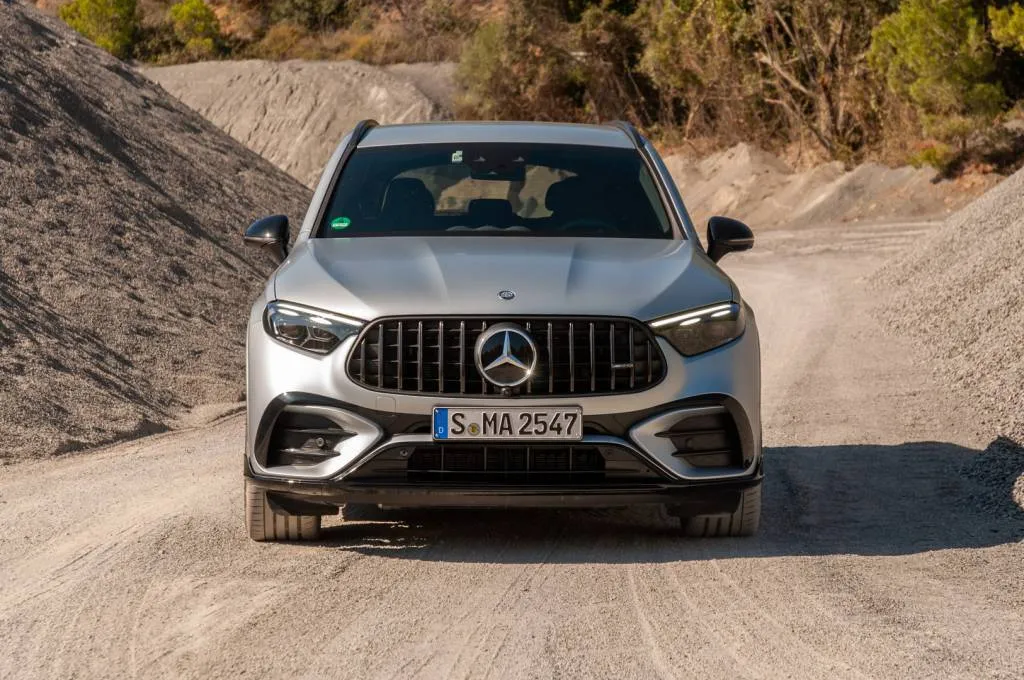
GLC 63 S E Performance is complicated
The brakes are the low point of the car’s dynamics. The system combines friction and regenerative braking at all times, and its tuning lacks bite. While the brake pedal is progressive in its pressure and stopping power, I find no hard bite at any point through the pedal travel. It’s a wooden feeling that makes it hard to inspire confidence despite knowing the brakes are strong. The standard brakes are 15.4-inch front and 14.6-inch rear rotors paired with 6-piston fixed front and 1-piston floating rear calipers.
Carbon-ceramic brakes will be an option, though not at launch. That upgrade might solve the problem, depending on the system calibration.
2025 Mercedes-Benz AMG GLC 63 S E Performance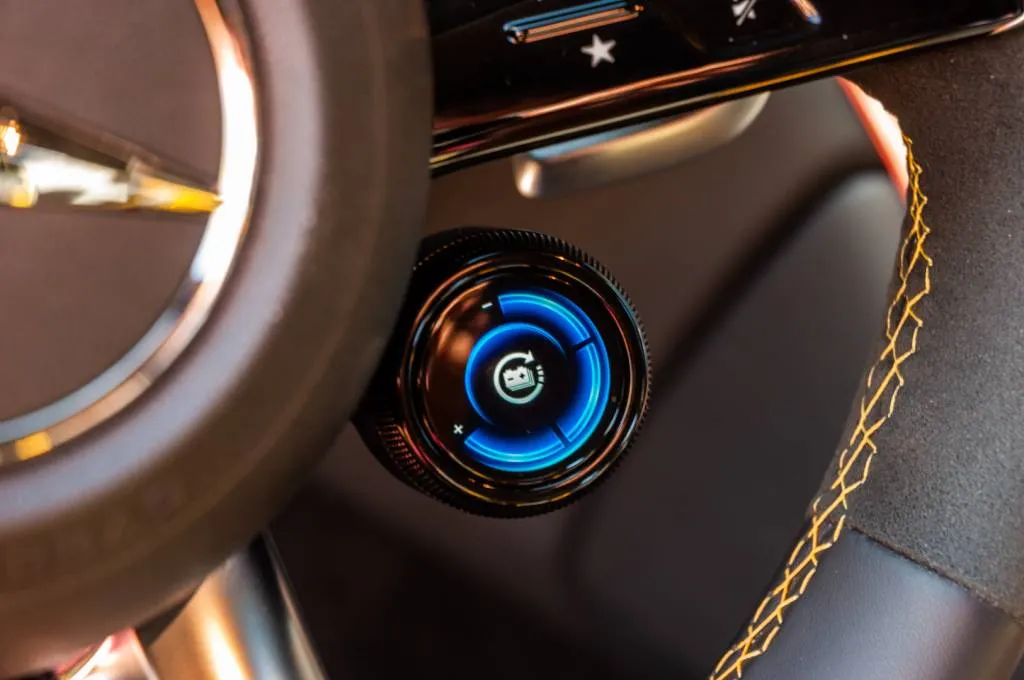
The GLC 63’s regenerative braking levels can be changed, but I can’t figure out how during my initial drive. Hours later I ask AMG’s Director of Vehicle Development Steffen Jastrow how to change them. He taps the little round screen on the steering-wheel mounted drive mode selector and the graphic changes from the current drive mode setting to a battery with an arrow circling it. I didn’t know that this screen is actually a button.
I head out to play with the regenerative braking system, but Steffen warns me, “the battery is nearly fully charged up, so you won’t be able to go to level four. There’s too much juice in the pack.”
I turn the drive mode selector to EL for Electric Mode. The Starship Enterprise noise is back. If you mash the accelerator to the floor, even in electric-only mode, the engine will fire. The turbo-4 powertrain sounds…fine. It has a gruffness that fits with the AMG brand. I quickly run the battery down to the halfway point, which allows me to crank the regenerative braking to Level 4. Note: It’s actually level three on the screen, AMG counts 0 as the first level, which is weird and confusing.
Steffen said Level 4 would enable one-pedal driving. It doesn’t. Regenerative brake drag becomes noticeable and slows the GLC down as if the brakes were partially engaged, but it doesn’t bring the GLC 63 to a complete stop. I am able to slow the GLC to 3 mph, but it just keeps rolling. Level 0 adds no extra pull, while Level 1 is barely noticeable. It’s probably the level most people should use on a daily basis, as it’ll recharge the battery quicker but doesn’t really intrude on daily driving. Levels 2 and 3 feel like a weird middle ground and don’t seem to make sense.
2025 Mercedes-Benz AMG GLC 63 S E Performance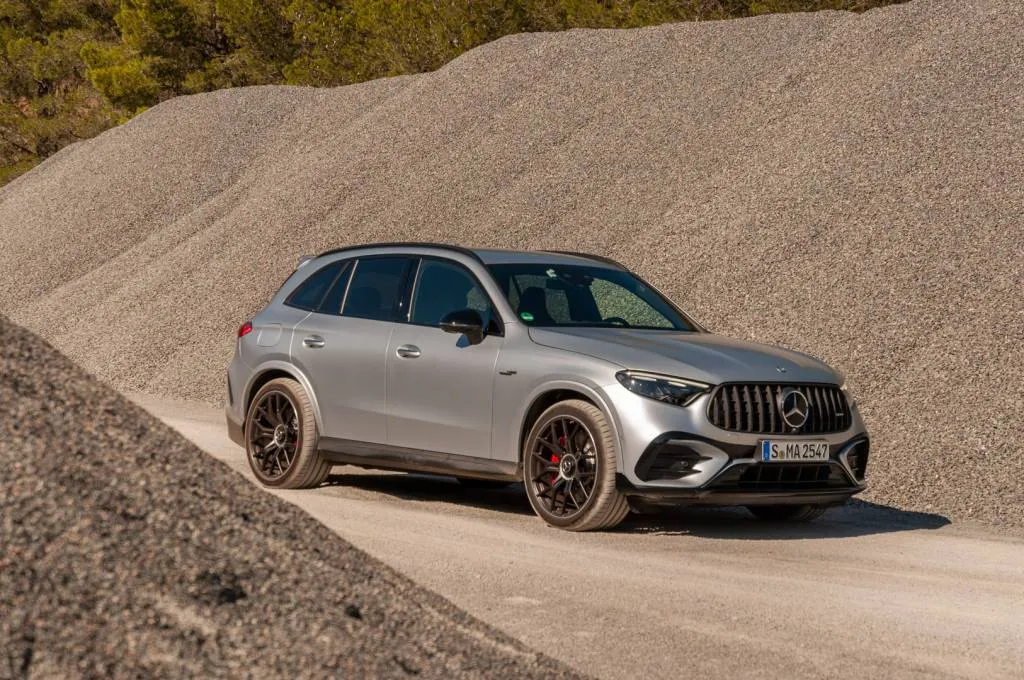
GLC 63 S E Performance emphasizes performance over efficiency
While we know the battery size, Mercedes isn’t ready to talk about how long the GLC 63 S E Performance will take to charge. It can’t be that long on a Level 2 240-volt charger given the 6.1-kwh pack.
That pack size also severely limits how far the GLC can be driven on electricity alone before firing up the gas engine. Steffen said the European-spec cars we drove have an all-electric driving range of 12 km, which is 7.5 miles. But that’s measured on the European WLTP efficiency cycle, which is kinder than the U.S.’s EPA cycle. It might only have about 5 miles of electric-only range as measured here.
That pack likes to keep its energy level between 20% and 95%. In certain situations, notably while sitting in a parking lot “idling,” the system will let the battery discharge down to 10%, but no less. Steffen said the system keeps a reserve to ensure there’s full power at any given time when the accelerator is put to the floor. Above 95% the system will shed energy to the rear motor to ensure there’s room for recuperation from the braking system.

2025 Mercedes-Benz AMG GLC 63 S E Performance

2025 Mercedes-Benz AMG GLC 63 S E Performance
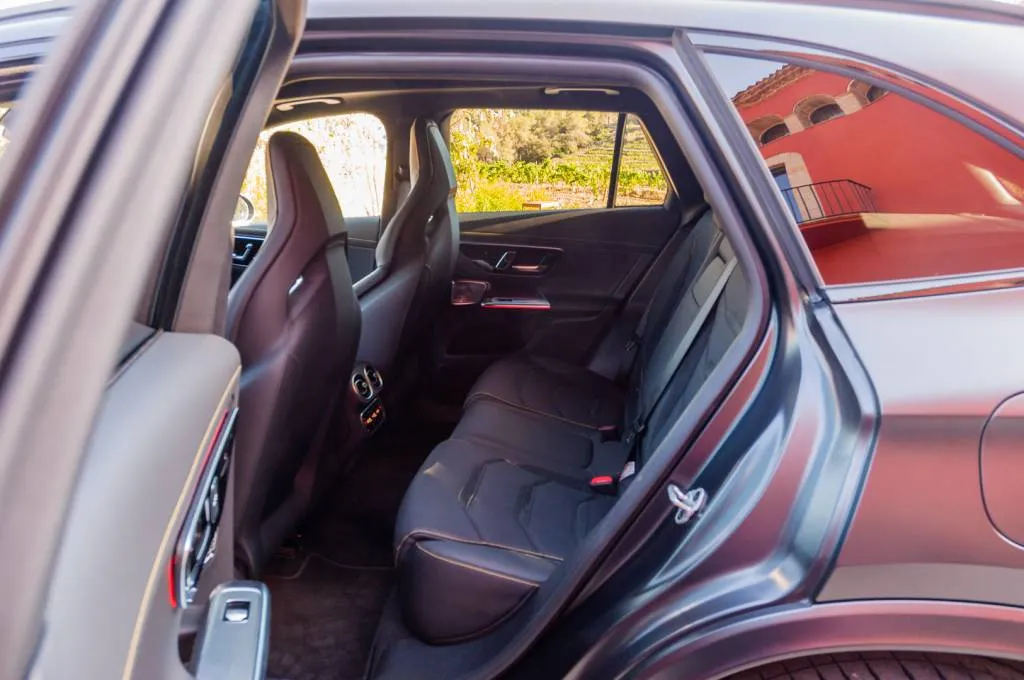
2025 Mercedes-Benz AMG GLC 63 S E Performance
GLC 63 S E Performance AMG-ifies the interior
The interior of the GLC 63 S E Performance from the B-pillar forward is essentially lifted out of the C-Class sedan. Aft of the B-pillars it’s a GLC with finer materials. Up front, it has a pair of sport bucket seats with electronically adjustable bolsters that will give some love to love handles. My average build fits perfectly. Everything’s covered in nappa leather, suede, shiny piano black plastic, silver trim, and/or carbon fiber. It’s a welcoming, high-quality, and sporty environment, though the piano black plastic will eventually get scratched up. The display graphics are AMG-specific, but they’ll feel familiar, as will the controls, or what’s left of them, to anyone who’s been in a recent Mercedes product.
Mercedes hasn’t said how much the 2025 GLC 63 S E Performance will cost, but expect a price hike over the $85,000 of the last model thanks to that expensive powertrain. F1 tech isn’t cheap.
Throughout my time with the GLC 63 S Performance, conflicting thoughts kept running through my head. My main thought was, “this is both great and just so overly complicated.” That naturally led to, “man, I kind of miss the V-8,” followed by “why aren’t we just skipping straight to the electric future?” The future may be good or bad, but for now, I’ll enjoy this stepping stone on the journey.
Mercedes-Benz paid for travel and lodging, which included sketchy wifi, to bring you this firsthand report.
